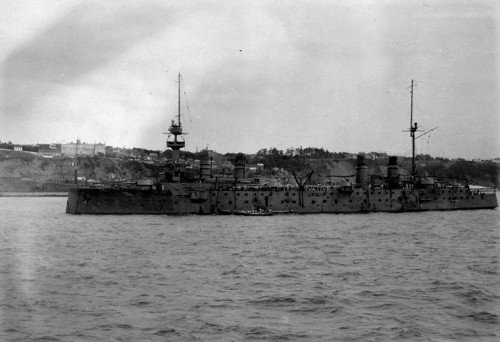French cruiser Amiral Aube.
Deck scene on the French ship Amiral Aube.
HMS Cochrane.
With the Turkish entry into the war in the autumn of 1914 the only route for British and French supplies to Russia was through Russia’s Arctic ports. As the war progressed and Russian need for war materiel, food and coal increased so the shipments grew. Arctic Russia was one of the least developed parts in the west of the country and during the winter months weather conditions were extreme. Archangel, the main port, had reasonable facilities and a railway connection, but was closed by ice from December to May; Murmansk was ice-free all year round, but considerably smaller and had no railway connection until 1917. Both were completely overwhelmed by the quantities of supplies shipped in.
Until 1917, apart from the occasional U-boat patrol or minelaying operation, the region was free of German activity. A small British naval force was based at Murmansk from 1915 onwards. The expansion of the U-boat war in 1917 had minimal impact, but the political turmoil in Russia, that also led to the independence of Finland, did. A force of marines arrived in June 1918 to secure Murmansk followed by other allied troops. In August another force was sent on to Archangel to secure the vast stockpiles of supplies. By then the Allies had decided to restore the former Russian government and forces were sent south along the railway and rivers with the object of linking up with other anti-Bolshevik and anti-German forces. Throughout the winter the campaign stalled and a Bolshevik offensive in early 1919 forced the Allies back towards Archangel. This led to a larger expedition being sent out in the summer, though by then the political appetite for intervention in Russia had waned and it was withdrawn.
